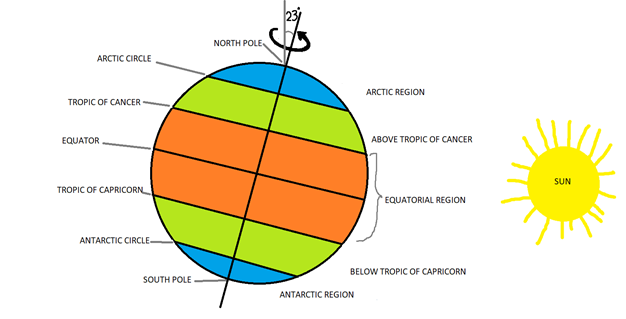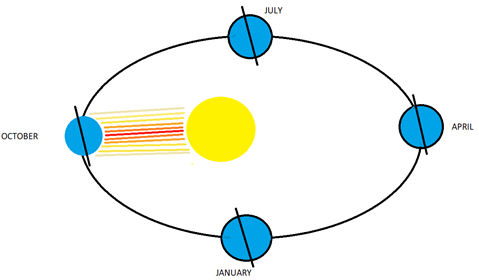
Which area of the Earth receives maximum sunlight?
A) Polar region
B) Equatorial region
C) Along the latitude of tropic of cancer
D) Along the latitude of tropic of Capricorn
Answer
475.5k+ views
Hint: Polar regions start from the point where the axis line of the Earth’s rotation passes through. The Equatorial region lies between the lines- tropic of cancer and tropic of Capricorn, this also contains the equator line which lies in the center of the earth and directly faces the sun. The region along the tropic of cancer stretches up to the arctic circle, while the region along the tropic of capricorn stretches up to the Antarctic circle.
Complete step by step solution:
This diagram will give a better understanding of the concept.

When the Earth revolves around the Sun, It creates a slightly elliptical orbit like this-

All around the year, the Earth is
The earth’s surface is divided into a number of parallel, horizontal, imaginary lines called Latitudes. The location of latitude is specified using the angle which it makes with the central latitude called the Equator line, it is marked as
Due to the curved spherical surface of the Earth, the amount of sunlight that reaches a particular latitude is proportional to its cosine.
Where I is the amount of sun’s light that reaches the area.
And
This can be useful to calculate the share of sunlight in each area.
Since,
And,
So moving from the equator to the poles we find a decrease in the amount of sunlight that falls on earth.
The earth has 3 types of zones-
1. The equatorial zone- Lies between the tropic of cancer (
2. The temperate zone- Lies between the tropic of cancer (
3. The polar region- Lies between the arctic circle (
Since
Note: Even if the earth’s axis is inclined, the portion of the Earth which receives maximum sunlight remains on the Equatorial region, because the tropic of cancer and the Capricorn, which act as a borderline between temperate and equatorial region is placed at around
Complete step by step solution:
This diagram will give a better understanding of the concept.

When the Earth revolves around the Sun, It creates a slightly elliptical orbit like this-

All around the year, the Earth is
The earth’s surface is divided into a number of parallel, horizontal, imaginary lines called Latitudes. The location of latitude is specified using the angle which it makes with the central latitude called the Equator line, it is marked as
Due to the curved spherical surface of the Earth, the amount of sunlight that reaches a particular latitude is proportional to its cosine.
Where I is the amount of sun’s light that reaches the area.
And
This can be useful to calculate the share of sunlight in each area.
Since,
And,
So moving from the equator to the poles we find a decrease in the amount of sunlight that falls on earth.
The earth has 3 types of zones-
1. The equatorial zone- Lies between the tropic of cancer (
2. The temperate zone- Lies between the tropic of cancer (
3. The polar region- Lies between the arctic circle (
Since
Note: Even if the earth’s axis is inclined, the portion of the Earth which receives maximum sunlight remains on the Equatorial region, because the tropic of cancer and the Capricorn, which act as a borderline between temperate and equatorial region is placed at around
Recently Updated Pages
How do you factor x2 + x 20 0 class 9 maths CBSE

How do you solve y6x and 2x+3y20 using substitutio class 9 maths CBSE

Chipko movement originated in Gopeshwar in A 1953 B class 9 biology CBSE

The adjacent sides in the parallelogram are supplementary class 9 maths CBSE

The compound used in plastic industry is A Vinyl acetate class 9 chemistry CBSE

How do you solve for y in 2left y dfrac12 right 4left class 9 maths CBSE

Trending doubts
What is the color of ferrous sulphate crystals? How does this color change after heating? Name the products formed on strongly heating ferrous sulphate crystals. What type of chemical reaction occurs in this type of change.

Worlds largest producer of jute is aBangladesh bIndia class 9 social science CBSE

Distinguish between Conventional and nonconventional class 9 social science CBSE

What was the Treaty of Constantinople of 1832 class 9 social science CBSE

What is a legitimate government class 9 social science CBSE

Describe the 4 stages of the Unification of German class 9 social science CBSE




